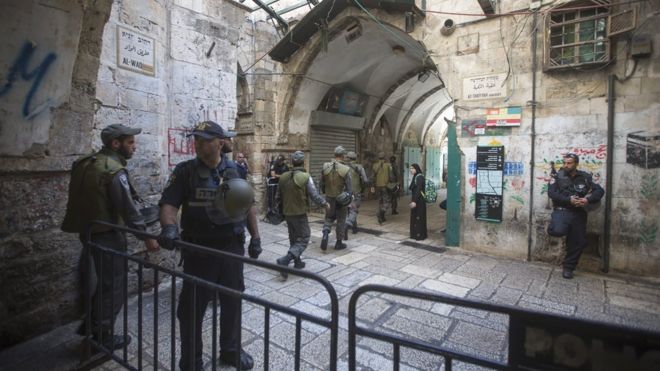Violence in Jerusalem here to stay

Friends and family carry the body of Aharon Banita, an IDF soldier, who was stabbed to death by a Palestinian youth in an attack in the Old City, October 3rd. Photo by Yonatan Sindel/Flash90
3rd intifada?
Like the Palestinians, Israelis Will Have to Get Used to a Violent Jerusalem
There is no way to know if the recent escalation is the start of a third intifada. But even if not, the violence in Jerusalem is here to stay.
By Nir Hasson, Haaretz
October 06, 2015
After the end of the holiday on Monday, the Jerusalem light rail resumed service, but the cars did not complete their journeys. They were stopped at the French Hill intersection, before reaching the Arab neighbourhoods of Shoafat and Beit Hanina, and the Jewish neighbourhood of Pisgat Ze’ev.

Palestinians run from tear gas smoke during clashes with Israeli security forces at the Qalandia checkpoint between Jerusalem and Ramallah in the West Bank, on October 6, 2015. Photo by Abbas Momani / AFP
The disturbances that began in the afternoon on the main road and on the railroad tracks in Shoafat continued into the night, and the police suspended rail traffic.
Mohammed Abu Khdeir was snatched from near the tracks in Shoafat on the July 2014 night of his murder, which ignited a wave of violence the likes of which had not been seen in Jerusalem since the 1990s. The light rail in Shoafat became a symbol of that mini-intifada; its tracks, stations and other infrastructure were targetted by angry Palestinian youths. But the damage was repaired, service was restored within three weeks, and except for the occasional rock thrown at a carriage and a decline in passengers from Pisgat Ze’ev, life returned more or less to normal, until Monday.
That is not the only similarity to the events of last year: There were also the hundreds of Jews running through the streets shouting “Death to Arabs” in response to a terror attack, the dozens of masked Palestinians throwing rocks and Molotov cocktails, the police surveillance balloons, the sound of sirens slicing through the city, the morbid negotiations over the release of terrorists’ bodies to their families in a bid to prevent their funerals from escalating the violence, and more.

Israeli police patrol the Old City of Jerusalem after the ban on Palestinians was imposed. Photo by EPA.
But the closure of the Old City to Palestinian non-residents was a new, and very troubling, twist. In an attempt to justify the move, Jerusalem Mayor Nir Barkat said that streets were also closed to Jews during Muslim holidays. But this argument is weak. It was not only one street that was closed to Palestinians, but all of the Old City – to a great extent the business and cultural centre of East Jerusalem. This is like closing the Jaffa-Ben Yehuda-King George street triangle at the heart of western Jerusalem. But maybe even more disturbing was the fact that the decision to let people into the Old City at the checkpoints was based on appearance – a disturbing and painful proof to anyone who thinks that Jerusalem is a normal city that it is only an illusion.

Palestinians throw stones during clashes with Israeli troops at Qalandia checkpoint between Jerusalem and Ramallah, Tuesday, Oct. 6th, 2015. “A new generation of angry, disillusioned Palestinians is driving the current wave of clashes with Israeli forces: They are too young to remember the hardships of life during Israel’s clampdown on the last major uprising, and after years of nationalist Israeli governments many have lost faith in statehood through negotiations and believe Israel only understands force.” Caption by Yahoo, photo by Majdi Mohammed/ AP
Jerusalem is deceptive. By Monday afternoon, the illusion of normalcy had returned. In typical Israeli fashion, after slightly more than 24 hours, what had been planned as a 48-hour closure began to give. Security checks at the Jaffa and New gates turned perfunctory, while continuing at Damascus Gate. Some businesses in the Muslim Quarter were open and in the Christian Quarter it was business as usual. Tourists thronged the Old City. The Palestinians have a remarkable ability to adapt to arbitrary restrictions.
“Optimism has been with us from the day we were born until we die,” says Ihab Barakat, the owner of a cafe with the optimistic name “Ir Hashalom,” (city of peace), located not far from where Aharon Benett, 21, and Nehemia Lavi, 41, were stabbed to death on Saturday. “All we need is some faith,” he says.

Mourners carry the body of 13-year-old Palestinian Abdel Rahman Abdullah, who was shot dead by the Israeli army during clashes at a refugee camp near Bethlehem, during his funeral at the Aida refugee camp on October 6, 2015. Photo by Musa al-Shaer/AFP
But only hours later the capital sinks back into violence – in Beit Hanina, a Palestinian man was seriously wounded after he was shot in the chest; in Pisgat Ze’ev a Jewish man was lightly wounded by a rock thrown at him; In Abu Tor, a fire broke out after someone threw a firebomb; and in Isawiyah, clashes with Israeli security forces resumed, even more intensively. And the light rail was again stopped at the French Hill. The circle is complete.
There is no way to know whether this is the start of a third intifada, but it seems clear that the violence in Jerusalem will continue. Even if there are calmer periods ahead, even if shops will be opened and shoppers will return, the violence in Jerusalem will not subside, so-called “lone wolf” attackers will not put done their arms, and neither will the stone-throwers. And we Israelis, like the Palestinians, will have to adapt to it.
